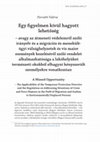Papers by Valéria Horváth

Európai Tükör, 2021
Az Egyesült Nemzetek Szervezetének menekültügyi intézménye (UNHCR) szerint 2017-benösszesen 30,6 ... more Az Egyesült Nemzetek Szervezetének menekültügyi intézménye (UNHCR) szerint 2017-benösszesen 30,6 millió ember kényszerült újonnan elhagyni lakóhelyét világszerte. Ezeknek az embereknek több mint fele – a közvélekedéssel ellentétben – nem fegyveres konfliktus miatt kényszerült elhagyni lakóhelyét, hanem természeti katasztrófa miatt. Ebből kifolyólag az ENSZ felfogása szerint az államok kötelesek humanitárius védelmet nyújtani minden embernek. A nemzetállamok álláspontja szerint azonban a lakóhelyüket tömeges mértékben elhagyni kényszerülők veszélyt jelentenek a befogadó ország gazdasági, társadalmi és politikai biztonságára. Gyakran azonban ezeket a biztonsági kockázatokat képtelenek egyedül kezelni. Mindeközben az EU számos, különböző olyan jogsegélyt nyújt a tagállamoknak, mint például a 2001-es Átmeneti Védelemről szóló Irányelv. Mivel az Európai Unió nem tudta a rendelkezésre álló eszközökkel megfelelően kezelni a 2015-ös migrációs válságot, az Európai Bizottság 2020-ban bejelent...
Although the issue of climate change mitigation and adaptation is fortunately evermore widely dis... more Although the issue of climate change mitigation and adaptation is fortunately evermore widely discussed, the problems facing ‘climate refugees’ only appears sporadically in the discussions adding to the current confusion. Taking recent and forecasted trends into account, the UN declares that states have serious moral obligations to provide humanitarian protection to all those displaced. The question which the international community and international lawyers face is whether states have more than just a moral obligation to provide protection. In this paper I will assess whether or not there are any roots in the various sources of international law – such as conventional law, customary international law, or the fundamental principles of international law – for the legal definition of ‘climate refugees’.

Pécsi Határőr, 2018
HU: A klímaváltozás az emberiség legnagyobb kihívása a XXI. században, amely közvetve vagy közvet... more HU: A klímaváltozás az emberiség legnagyobb kihívása a XXI. században, amely közvetve vagy közvetetten számos gazdasági, társadalmi, politikai és jogi problémakört vet fel. A leglátványosabb ilyen problémakör napjainkban a migráció. Amennyiben természeti csapásoknak vagy a klímaváltozással összefüggő gazdasági negatív trendeknek, illetve válságoknak, és ebből fakadóan akár fegyveres konfliktusnak van kitéve, az ember természetes reakciója a migráció. A Nemzetközi Migrációs szervezet szerint 2050-re a "klímamigránsok" száma elérheti a 25 milliót, de akár az 1 milliárdot is. A „klímamigránsok” jogi definiálása során megfontolandó tények: (1) kényszermigrációról vagy önkéntes, (2), határon belüli vagy azon keresztüli, (3) átmeneti vagy állandó migrációról van-e szó. Ezzel együtt a köznyelvben használatos „klímamenekültek” nemzetközi jogilag nem tekinthetők „menekültnek”, a jelenlegi nemzeti idegenjogi jogszabályok pedig kifejezetten a klímaváltozást vagy annak következményeit nem ismerik el egy másik országba történő bevándorlást megalapozó jogcímnek, míg az ENSZ Menekültügyi Főbiztossága a klímaváltozással összefüggő migrációt kizálóag egy adott ország határain belüli migrációval azonosítja.
EN: Climate change is the greatest challenge of humanity in the 21st century, which directly or indirectly raises numerous economic, social, political and legal issues. As such, the most visible issue nowadays is migration. If and when humans are subjects of a natural disaster or the economic downgrade or even armed conflict related to climate change, the natural reaction is to migrate. According to IOM the number of „climate migrants” in the world may be anything from 25 million to 1 billion. In order to legally define „climate migration” principally the following aspects should be considered: (a) is it involuntary/forced or voluntary migration; (b) is it internal or cross-border/international migration; and (c) is it temporary/circular or permanent migration. „Climate refugees”, as defined colloquially, do not qualify as „refugees” under international law; whereas in national alien law, climate change explicitly does not constitute legal grounds for immigration; while UNHCR defines migration related to climate change merely as internal displacement within the borders of a country.










Uploads
Papers by Valéria Horváth
EN: Climate change is the greatest challenge of humanity in the 21st century, which directly or indirectly raises numerous economic, social, political and legal issues. As such, the most visible issue nowadays is migration. If and when humans are subjects of a natural disaster or the economic downgrade or even armed conflict related to climate change, the natural reaction is to migrate. According to IOM the number of „climate migrants” in the world may be anything from 25 million to 1 billion. In order to legally define „climate migration” principally the following aspects should be considered: (a) is it involuntary/forced or voluntary migration; (b) is it internal or cross-border/international migration; and (c) is it temporary/circular or permanent migration. „Climate refugees”, as defined colloquially, do not qualify as „refugees” under international law; whereas in national alien law, climate change explicitly does not constitute legal grounds for immigration; while UNHCR defines migration related to climate change merely as internal displacement within the borders of a country.
EN: Climate change is the greatest challenge of humanity in the 21st century, which directly or indirectly raises numerous economic, social, political and legal issues. As such, the most visible issue nowadays is migration. If and when humans are subjects of a natural disaster or the economic downgrade or even armed conflict related to climate change, the natural reaction is to migrate. According to IOM the number of „climate migrants” in the world may be anything from 25 million to 1 billion. In order to legally define „climate migration” principally the following aspects should be considered: (a) is it involuntary/forced or voluntary migration; (b) is it internal or cross-border/international migration; and (c) is it temporary/circular or permanent migration. „Climate refugees”, as defined colloquially, do not qualify as „refugees” under international law; whereas in national alien law, climate change explicitly does not constitute legal grounds for immigration; while UNHCR defines migration related to climate change merely as internal displacement within the borders of a country.